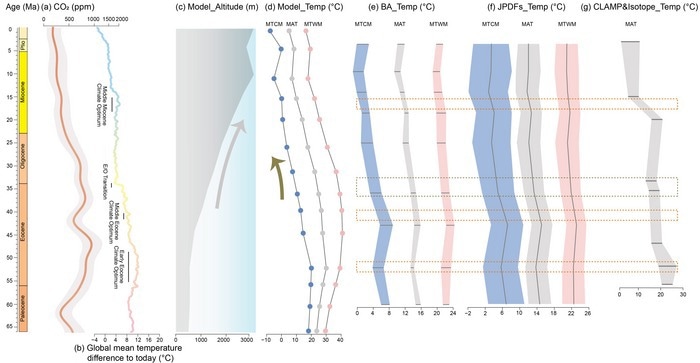The Paleoecology Research Group (PRG) of the Xishuangbanna Tropical Botanical Garden (XTBG), Chinese Academy of Sciences (CAS), is in command of this study. The Second Tibetan Plateau Scientific Expedition and Research (STEP), which is focused on studying Cenozoic paleobotany and paleoenvironmental changes, has a paleontological scientific expedition team that is primarily comprised of the PRG.
 (a) Global CO2 concentration was estimated from the multiproxy dataset compiled by Tierney et al. (2020), the CO2 error envelopes represent 1σ uncertainties; (b) Global mean temperature was estimated from benthic δ18O by Westerhold et al. (2020), and (c) Simulated mean values of altitude on the QTP. Image Credit: Science China Press
(a) Global CO2 concentration was estimated from the multiproxy dataset compiled by Tierney et al. (2020), the CO2 error envelopes represent 1σ uncertainties; (b) Global mean temperature was estimated from benthic δ18O by Westerhold et al. (2020), and (c) Simulated mean values of altitude on the QTP. Image Credit: Science China Press
The paleoenvironment and paleoclimate can be recreated using plant fossils since they are accurate and direct indicators of environmental conditions.
Outstanding advances in paleobotany have been made in the Tibetan Plateau as a result of the ongoing STEP; several fossil floras with well-constrained geological dates have been found and documented.
The researcher collected macrofossils and palynological fossils from the Paleogene to Neogene (66–2.58 Ma) for 48 fossil floras in this area. They also presented a quantitative climatic reconstruction based on this data using Bioclimatic Analysis (BA) and Joint Probability Density Functions (JPDFs).
The research team used the Hadley Centre Coupled Model version 3 (HadCM3) from the University of Bristol in the UK to perform paleoclimate simulations in several geological eras in collaboration with Prof Paul J. Valdes and Dr. Alex Farnsworth.
Subsequently, to examine the climate evolution during the Cenozoic, the quantitative reconstructions made using fossils and numerical models were compared with one another.
The researchers came to the conclusion that the climate on the Tibetan Plateau exhibits an overall cooling trend under the influence of global climate change and the plateau’s expansion after integrating various sources of evidence, including plant fossil records, climate simulations, and other proxies.
The dramatic climate change was very likely driven by Tibetan uplift during the late Eocene (around 35 Ma), the temperature was shifted from a latitudinal distribution pattern to a topographically controlled pattern.
Jiagang Zhao, Study First Author, Chinese Academy of Sciences
The numerical simulations also demonstrate a progressive drop in temperature and precipitation in the northeastern region of the plateau.
This study can serve as a foundation for understanding how changes in climate, vegetation, and the biological environment are related to the expansion of the Tibetan Plateau.
Journal Reference:
Zhao, J., et al. (2022) The Paleogene to Neogene climate evolution and driving factors on the Qinghai-Tibetan Plateau. Science China Earth Sciences. doi:10.1007/s11430-021-9932-2